Perspective From the Field: Illegal Puppy Imports Uncovered at JFK Airport
by Molly K. Houle, DVM*
At New York City’s John F. Kennedy International Airport, the belly of the Boeing passenger jet opened to reveal the cargo hold filled with stacked crates of whimpering dogs, many more than usual. All were young puppies—most too young to leave their mothers—cowering and huddling in their cages, shivering while covered in their own waste after their long international flight. Witnessing the scene was a team of federal agents from the US Customs and Border Protection (CBP) and Centers for Disease Control and Prevention (CDC), and JFK’s veterinarians accredited by the US Department of Agriculture (USDA).
“I just wanted to take them home,” said the burly CBP officer at seeing the puppies’ miserable plight. A 17-year expert on preventing narcotics smuggling, Deputy Chief of Cargo James Bowles realized he was confronting another kind of illegal importation, of the cuter variety.
In October 2017, Deputy Chief Bowles first overheard fellow officers complaining about hordes of puppies arriving at JFK on international flights. Brushing it off as a fluke, his mind changed when underage puppies started arriving weekly, even daily, in large shipments of 44 or 48 at a time, as opposed to 1 or 2 passengers’ pets. In response, Bowles drafted a heightened surveillance plan to address these illegal puppy importations, finding it similar to busting narcotics smugglers. He named the plan “Operation Dog Catcher.” To form a strike team, he brought in CDC public health officers and veterinarians from AirHeart Pet Hospital inside The ARK, CBP’s biosecurity, 24-hour animal care and veterinary facility at JFK airport.
Government regulations
CBP functions on our country’s front lines to secure US borders while facilitating lawful travel and trade. Stationed at more than 300 US ports of entry, CBP works with 40 other US government agencies, including CDC, US Department of Agriculture (USDA), and the Food and Drug Administration, to enforce more than 400 federal laws. One of these laws is CDC’s federal regulation for proper rabies immunization for every dog arriving from a high-risk country for dog rabies before entering the United States.
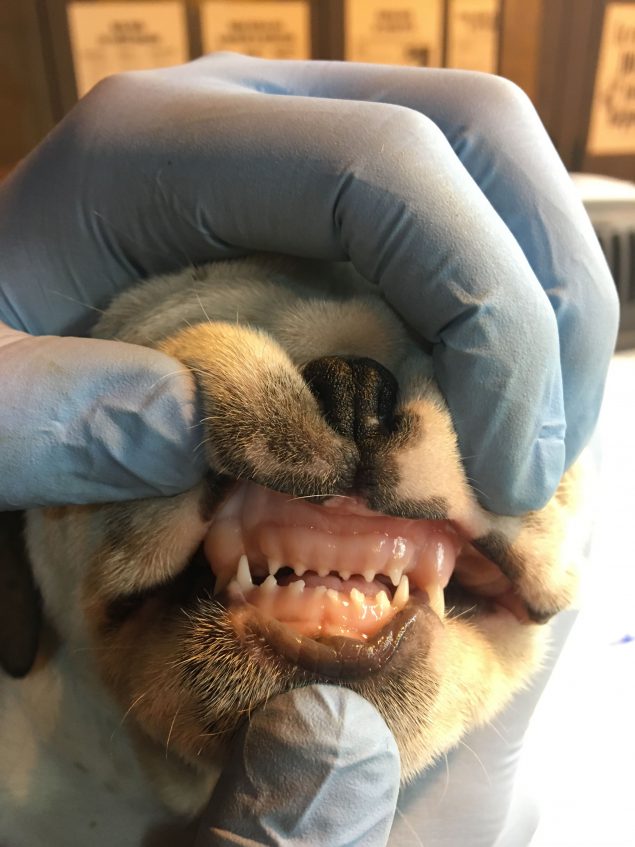
Puppies’ true ages can be determined by examining their teeth, even though illegal importers may falsify the dogs’ ages on their papers.
All dogs coming into the United States are required to be healthy. And they must be at least 4 months old to be properly immunized against dog rabies, which has been eradicated from the United States since 2007.
Puppies can’t be vaccinated for rabies before they’re 12 weeks old, because their mothers’ antibodies prevent the vaccine’s protection. CDC’s age requirement is timed for when puppies are developing their own immune system. When puppies are vaccinated at 12 weeks, it takes a month for them to gain their own protective rabies antibodies to be fully immunized. Rabies poses a public health risk. Rabies almost always causes death.
Further, USDA requires puppies to be healthy and at least 6 months old if imported for resale to help prevent the foreign fraudulent importation of sick and underage dogs. If dogs don’t meet CDC’s or USDA’s importation requirements, they may be deported back to their countries of origin.
USDA’s Animal and Plant Health Inspection Service (APHIS) oversees animal welfare pertaining to the shipment of puppies. Shipping dogs in crates as cargo has its risks. Since Operation Dog Catcher’s start at JFK, seven illegally imported underage puppies arrived dead in the United States. At higher risks for death are the popular French and English bulldogs (both brachycephalic breeds—their smooshed noses make it harder to breathe normally). Airlines in the United States have started banning these breeds from their flights, as do most airlines in Europe and Australia. In stressful, cramped conditions, they are especially prone to heat stroke and respiratory distress.
No matter how importers falsify puppies’ ages on paper, their true age can be determined by examining their teeth.
Illegal importers’ tricks
The motives behind illegal puppy importation are not immediately obvious. However, a closer look reveals a big business driven by profit at the expense of the health and welfare of the underage puppies. Importers aim to get around these regulations, because customers demand puppies as young as 8-weeks. Profits decline by the thousands with each month a puppy ages. The puppy-loving public creating the demand is part of the problem.
Many dogs are bred irresponsibly in large numbers in “puppy mills” overseas, where the risk of congenital abnormalities and disease is high. Importers then fly them as cargo in large batches, claiming them as “rescue” dogs, valued at $0 on their paperwork, and allowing the importers to evade entry and broker fees.
If the illegal puppies enter the United States, they are marketed to the public through social media such as Facebook and Twitter, or even on legitimate-looking US breeder websites. Some international importers cheaply breed or board high-demand types of puppies in the United States, such as French and English bulldogs, and other small breeds like Yorkshire terriers and chihuahuas. The dogs are then sold to unsuspecting families as well-bred, American-born puppies at a cost of $3,000 to 5,000 each. The potential profit is exponential.
Another ruse is to recruit a “flight parent,” offering travelers a free flight in exchange for claiming the dogs as their own on their flight to the United States. The importers tell the unsuspecting flight parent they are helping to transport rescue dogs to meet their adoptive owners at the airport. They then give a description of the new families or transporters and a meeting point at the airport to make the exchange. The transaction between the flight parent and the puppy’s new family leaves no paper trail.
Turning point for Operation Dog Catcher
In 2017, a Christmas-time shipment of dogs, including a 6-month-old chihuahua puppy, marked a turning point for the strike team and Operation Dog Catcher. The puppy was one of five dogs in cargo on an arriving international flight from Cairo, Egypt. They seemed to have proper paperwork and rabies vaccination certificates. All the dogs were permitted entry into the United States. As planned, the volunteer flight parents met with transporters to distribute the dogs for ultimate adoption in states widespread from Connecticut to Washington.
The chihuahua, in particular, was markedly agitated on the flight and bit the flight parent at the airport. The next day, the chihuahua bit a veterinary technician; then the puppy died on his second day in the United States. Lab results soon revealed the chihuahua had rabies. A collaborative effort between five state health departments, CDC, CBP, and APHIS contacted all people exposed, from cargo handler to adoptive parent, to ensure they and the other dogs received anti-rabies postexposure treatment to help prevent the disease. None of the exposed people developed rabies.
CDC and CBP officers suspected a fraudulent rabies vaccination certificate, sparking a new conversation at CBP about how to increase surveillance of dog imports and add procedures to better scrutinize puppies’ paperwork. Because the rabid puppy slipped through surveillance at JFK airport, CBP now requires all puppy shipments from suspicious importers and high-risk countries for dog rabies to go to The ARK, where they receive a thorough physical exam and paperwork inspection.
The ARK
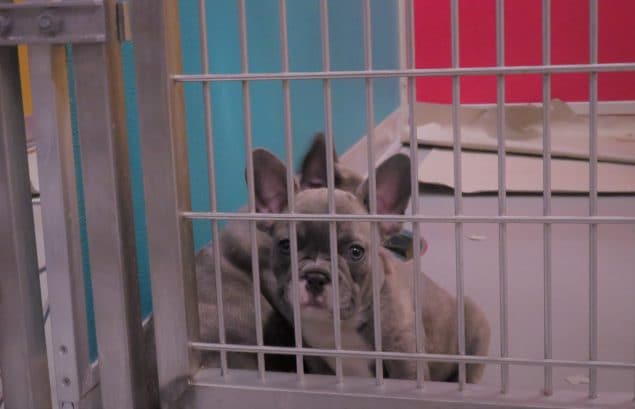
Lavender French bulldog puppies command high prices.
At the tarmac entrance of The ARK clinic, the steel exam table to the left gleams in front of cupboards filled with medical supplies. To the right are empty cat cages, stacked atop one another like bookshelves. Down the long hall, a few faint whines echo in the vast space of the spotless warehouse-like facility. The ARK’s Managing Director Elizabeth Schuette explains they provide boarding, veterinary care, and quarantine, and facilitate air travel for animals from birds to horses.
Soft squeaks and whimpers beckon from two rows of dog runs on either side of the hallway. Here’s where veterinarians care for imported underage puppies during their exam and paperwork inspection.
Three adjacent dog runs each house two velvety 7-week-old French bulldog puppies. The first two are spotted black and white, the next two are cream-colored, and the last two are the fashionable “lavender” color. Once stateside, these lavender Frenchies could be worth $10,000 to $15,000 each in the US puppy market. The other four of different colors are less valuable, but still worth $3,000 to 5,000 per pup.
Even from the opposite side of the cage door, each yawn and yip reveals their sparse, needle-like puppy teeth, indicating they can’t be more than 8 weeks old.
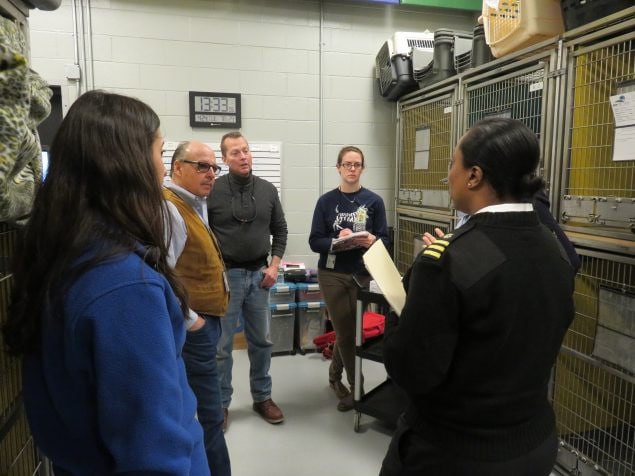
ARK staff, CDC experts, and JFK veterinarians partner to investigate imported underage puppies.
The puppies chase and tumble over one another in their runs. Although they seem like playful, healthy puppies, The ARK staff warns the puppy mill dogs have lived in poor, filthy conditions their whole lives, in sometimes abusive conditions that make them fearful of people. One veterinarian proves his point by cracking open the cage door—the two puppies rush to the back corner of their run, quivering as one fuzzy mound, their eyes white saucers.
Down the hall, seven longhaired chihuahuas—all varying in size and age—were separated into individual cages after their arrival to the United States that morning. As with the French bulldog puppies, CBP flagged their shipment as suspicious and had them transported to The ARK for inspection. Two underage puppies could fit in the palm of your hand, and they lay curled like croissants on their blankets, looking exhausted and sick next to dishes full of uneaten food.
The ARK-affiliated veterinary staff had to syringe-feed them a nutrient-dense gruel to prevent their blood sugar from dropping. Young puppies like these are at risk for life-threateningly low blood sugar, as well as hypothermia and respiratory infections during the long plane ride. The stress of the trip weakens their young immune systems, and they may have other diseases like kennel cough and parvovirus. Illegal puppies are not deported back to their country of origin until they are well enough to travel.
Public health implications
Linda Mittel, MSPH, DVM, a faculty veterinarian at Cornell College of Veterinary Medicine, works with The ARK on their biosecurity and standard operating procedures for horses. But since Operation Dog Catcher, she helps with the animal care procedures for dogs as well. While CDC’s dog importation regulations only require dogs to be healthy on arrival and have rabies vaccinations to protect the public’s health, Mittel explains rabies is not the only threat to human and animal health from these imported underage puppies. Parasitic diseases, such as tapeworm, roundworm, and Giardia infection, can spread quickly through dense populations of dogs and lead to disease in people. Skin infections, such as MRSA (methicillin-resistant Staphylococcus aureus, a drug-resistant bacterium), are known to be contagious between people and their pet dogs. Brucellosis (another disease caused by bacteria) is also a concern, particularly for American Kennel Club breeders and pet stores. At increased risk for these zoonotic (spread from animal to human) diseases are children, the elderly, and people on certain medications.
Cornell’s veterinary diagnostic lab researches flu viruses. Mittel expressed concern that some illegal, underage puppies are coming from areas where dog flu is common, and shipments of “rescue” dogs from those areas have been traced as the source of recent outbreaks in the US pet population. Of even more concern is the potential for dog flu to transform into a more severe strain, possibly becoming contagious between dogs and humans. In 2016, transmission of bird flu from cats to a human was documented in a New York City animal shelter. Although the disease was mild, a more severe strain could emerge from the sick underage puppies imported into the United States.
A new tactic
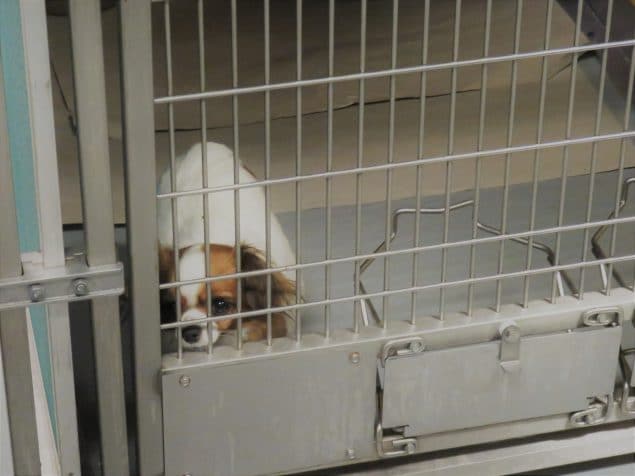
A pregnant longhaired chihuahua represents a new concern to the strike team.
At the very end of The ARK’s hall of dog runs, a pot-bellied, longhaired chihuahua presses her nose between the bars of her cage door. She may represent the test of a new tactic by illegal dog importers: a pregnant female within hours of delivering her litter. She was smuggled into the United States in a small, cat-sized carrier with two other dogs, an attempted evasion of CBP surveillance. Upon inspection at The ARK, however, her pregnancy was discovered.
Stressed from her ordeal, she cowers in the front corner of her cage. If this pregnant dog were released to the importer, within hours or days, two or three puppies would be born in the United States with no way of following up on the sale of the puppies. If not caught, the importer is a mere 8 weeks away from making thousands of dollars on each puppy. According to CBP, corrupt importers are willing to take this gamble for the potential payoffs, and they constantly evolve their methods to stay one step ahead of port authorities.
“I wish we could be proactive,” admitted Bowles, “but we’re forced to be reactive.”
Progress and port shopping
The first US port to recognize the rise in puppy importations was Miami International Airport. The airport developed a strike team to bust illegal importers. This apparently led the influx of dogs to shift north to JFK airport. Now that Operation Dog Catcher has streamlined CBP and CDC surveillance in New York, illegal importers have again felt the effects, and large shipments containing 20 to 40 dogs have slowed. But the underage puppies still keep coming.
Smaller shipments of 1 to 10 puppies have kept CDC’s New York quarantine public health officers busy. Operation Dog Catcher takes the majority of their workday, even spilling over into off hours. Importers often attempt to ship puppies on overnight flights, seeing an opportunity for easier entry into the United States. But CDC’s public health officers are on call day and night.
CBP has generated a list of problem importers and countries on their radar. As soon as the plane wheels hit JFK’s runway, officers are notified if the shipment seems suspicious. CDC continues tracking the puppies from cargo to The ARK, where USDA-accredited veterinarians examine them and determine their ages. The puppies’ status updates come often, awakening the CDC on-duty officer three to four times per night. On a weekend, shipments may take 8 hours for CDC to process because of limited staff.
For the larger shipments, illegal importers now go port shopping, looking for the easiest entries into the United States that may not have veterinary staff on site to properly examine the puppies. Other airports, such as Dallas, Philadelphia, and Newark, report dogs coming in en masse.
Public awareness
“The only way we can stop this problem is to shut down demand,” said CDC’s Yonette Hercules, officer in charge of the New York Quarantine Station. “It’s important to be a responsible dog owner and realize taking a puppy away from its mother too soon is not healthy and is creating inhumane conditions for their breeding and shipment.” Make sure you know what you’re buying. Be diligent in researching breeders and verifying their online advertisements. Locate ethical US dog breeders by visiting their facilities, and see how they raise puppies.
Purebreds and mixed-breed dogs of all ages are also available for adoption at credible animal shelters across the country. Many shelters conduct behavior testing to match adopters with their perfect companion. For those people looking to add a new pet to their family, seeking a rescue dog in the United States not only helps decrease our homeless pet population but also helps decrease demand for false rescue puppies sold illegally in the US market from international puppy mills. Once an educated public reduces demand, irresponsible overbreeding and fraudulent importation will hopefully cease.
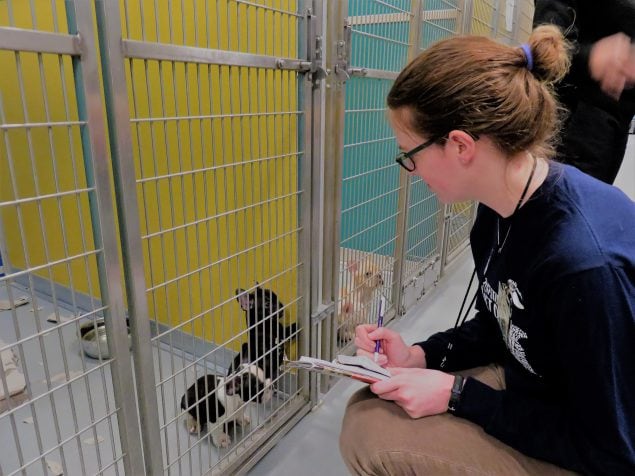
Molly Katherine Houle is a graduate of the University of Illinois College of Veterinary Medicine. She is pursuing a master’s degree in public health and has completed a 6-week internship at CDC with the Division of Global Migration Health’s Zoonoses Team that is responsible for CDC’s dog importation regulations.
*The findings and conclusions in this report are those of the author and do not necessarily represent the official position of the Centers for Disease Control and Prevention.